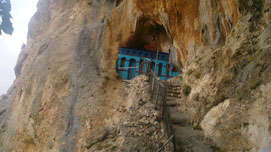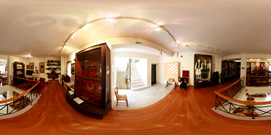Cultural and Tourist Resources of the Area
Display 12 - 22 of 44
Cave of Arsali (Saint Jerusalem)
In the higher grounds of the fir-covered Oiti Mountain, stands an enormous cave that looks like a Cyclops's eye that is vigilant for his kingdom. It is the cave of Arsali (Saint Jerusalem) where the residents of Ypati, in her honour, formed an internal part into a church and celebrate her on the Thursday after the Orthodox Easter with festivities accorded to the local customs.
History | Monument |
Damasta Monastery
The Damasta Monastery, is dedicated to the Birth of the Virgin Mary, it is located in the municipal prefecture of Damasta in a magical landscape and it is a female monastery. Its early history is not known. The catholic (main church of the monastery) dates back to the 11th century with religious icons dating back to 1818.
Religion | Temple |
Folklife Museum of Fthiotida
The Folklore Museum of Fthiotida is part of the Museum Bureau of the corresponding intendancy of the Municipality of Lamia and was founded in 1984. It displays folklore exhibits of great value that help the visitor reconstruct the picture of the goods and of the daily routine in the pre-industrial society.
Folklore | Museum |
Kolonus hill in Thermopylae
Opposite the contemporary Leonidas' Memorial stands a low hill that has been identified with Kolonus where the final phase of the Battle of Thermopylae took place. According to Herodotus' narration those who died fighting in the battle of Thermopylae were buried. In their honour a lion made of stone and three plain monuments were erected. Today on the top of the hill appears to be a representation of the epigram of Simonides of Ceos.
History | Archaeological site |
Pages
- « first
- ‹ previous
- …
- 2
- 3
- next ›
- last »













